Nyheter
Så här bygger Du en ETF portfölj
Publicerad
6 år sedanden

Tillväxten för börshandlade fonder, ETFer, har varit anmärkningsvärd sedan dess introduktion på 1990-talet. De fortsätter att växa i både antal och popularitet. Framväxten av detta investeringsverktyg har varit bra för placerarna, eftersom nya lågkostnadsmöjligheter nu är tillgängliga för nästan alla tillgångsklasser på marknaden. Emellertid måste investerare nu hantera ett urval av mer än 2 000 olika börshandlade fonder som handlas världen över. Detta kan vara en skrämmande uppgift för vilken helginvesterare som helst. Därför tittar vi närmare på hur det går att göra enklare, så här bygger Du en ETF portfölj.
Målet med denna artikel är att hjälpa dig att förstå grunden för börshandlade fonder och ge dig en inblick i hur du kan bygga din en ETF portfölj.
Fördelar med en ETF-portfölj
ETFer, eller börshandlade fonder som de också kallas för i Sverige, är korgar av enskilda värdepapper i likhet med fonder men med två viktiga skillnader. För det första kan ETFer handlas fritt som aktier, medan handel med fondandelar inte förekommer förrän marknaden stängs. För det andra tenderar utgiftsförhållandena att vara lägre än för fondandelar eftersom många ETFer är passivt förvaltade verktyg bundna till ett underliggande index eller marknadssektor. Traditionella aktiefonder är å andra sidan oftare aktiva förvaltade. Eftersom aktiva förvaltade fonder sällan slår index, utgör ETFer vanligen ett bättre alternativ till aktivt förvaltade, högkostnadsfonder.
Den främsta anledningen till att välja en ETF framför en aktie är omedelbar diversifiering. Till exempel, att köpa en ETF som spårar ett finansiellt index ger dig äganderätt i en korg av finansiella aktier jämfört med ett enda företag. Som den gamla klichén säger, vill du inte lägga alla dina ägg i en korg. En ETF kan skydda mot volatilitet (till en viss punkt) om vissa aktier som ägs av denna ETF faller i värde. Denna borttagning av företagsspecifika risker är den största fördelen för de flesta ETF-investerare.
En annan fördel med ETFer är exponeringen som de kan ge en portfölj till alternativa tillgångsklasser, såsom råvaror, valutor och fastigheter.
Välja rätt ETFer
När du bestämmer vilka ETF som passar bäst för din portfölj finns det ett antal faktorer att överväga.
Först bör du titta på ETFens sammansättning. Namnet ensamt är inte tillräckligt med information för att basera ett beslut på. Till exempel består flera börshandlade fonder av vattenrelaterade aktier. Men när de bästa innehaven av varje ETF analyseras är det tydligt att de olika börshandlade fonderna har olika tillvägagångssätt för nischsektorn. Medan en ETF kan bestå av vattenföretagen, kan en annan ha infrastrukturaktier som toppinnehav. Ett varierat fokus kommer att resultera i varierande avkastning.
Medan tidigare prestanda inte alltid är en indikation på framtida resultat, är det viktigt att jämföra hur liknande ETF har utvecklats. Även om de flesta avgifter för börshandlade fonder ETF är låga, kommer de att variera och bör beaktas.
Andra faktorer att vara uppmärksam på inkluderar de förvaltade tillgångarna. Detta är viktigt eftersom en ETF med låg förvaltad volym kan vara i fara för att stänga – en situation som investerare vill undvika. Investerare bör också titta på daglig genomsnittlig volym och spreaden, skillnaden mellan köp- och säljkurs. Låg volym och/eller en stor spread tyder ofta på låg likviditet, vilket gör det svårare att komma in och ut ur denna ETF.
3 steg för att bygga en ETF-portfölj
Om du funderar på att bygga din en ETF portfölj så följer här är några enkla riktlinjer:
Steg 1: Bestäm rätt fördelning.
Titta på ditt mål för den här portföljen (t.ex. pension, sparande för ett barn), dina förväntningar på avkastning och risk, din tidshorisont (ju längre den är desto större risk du kan ta), ditt utdelningsbehov (om du har inkomstbehov måste du köpa börshandlade fonder som betalar högre utdelningar), din skatte- och juridiska situation, din personliga situation och hur denna portfölj passar in med din övergripande investeringsstrategi för att bestämma din tillgångsallokering. Om du är kunnig om investeringar kan du kanske hantera detta själv. Om inte, sök hjälp av en finansiell rådgivare.
Slutligen överväga vissa data om marknadsavkastning. Forskning från Eugene Fama och Kenneth French resulterade i bildandet av trefaktormodellen vid utvärdering av marknadens avkastning. Enligt trefaktormodellen:
- Marknadsrisken förklarar en del av aktiens avkastning. Detta tyder på att aktierna i allmänhet överträffar obligationer över tiden eftersom aktier har mer marknadsrisk än obligationer.
- Värdeaktier överträffar tillväxtaktierna över tiden eftersom de i sig är mer riskfyllda.
- Small Cap-aktier överträffar Large Cap-aktier över tiden eftersom de har mer oföränderlig risk än deras large cap-motsvarigheter.
Därför kan investerare med högre risktolerans kunna och bör fördela en betydande del av sina portföljer till företag med mindre marknadsvärden som är värdeorienterade.
Kom ihåg att mer än 90 % av portföljens avkastning bestäms genom fördelning snarare än specifika aktieval och tidpunkt. Försök inte pricka en botten på marknaden. Forskning har kontinuerligt visat att tidpunkten för köp och försäljning av aktiern inte är en vinnande strategi. När du väl har bestämt rätt fördelning är du redo att genomföra din strategi.
Steg 2: Implementera din strategi.
Fördelen med börshandlade fonder är att du kan välja en ETF för varje sektor eller index där du vill ha exponering. Analysera tillgängliga fonder och bestäm vilka som bäst uppfyller dina allokeringsmål.
Eftersom tidpunkten är viktig när man köper och säljer ETF och aktier, är det inte en försiktig strategi att placera alla köporder på en och samma dag. Helst skulle du vilja titta på diagrammen för supportnivåer och alltid försöka köpa vid dippar. Fasa ut dina inköp under en period av tre till sex månader.
Vid inköpstillfället kommer många investerare att lägga en stop loss order som kommer att begränsa potentiella förluster. Helst bör stoppförlusten vara högst 20 % under det ursprungliga inköpspriset och bör flyttas i takt med att ETFen stiger i värde.
Steg 3: Övervaka och utvärdera.
Minst en gång om året bör kontrollera prestandan i din portfölj. För de flesta investerare, beroende på deras skatteförhållanden, är den ideala tidpunkten att göra detta vara i början eller slutet av kalenderåret. Jämför varje ETFs prestation med det hos referensindexet. Eventuell skillnad, kallad spårningsfel eller tracking error borde vara låg. Om det inte är det kan du behöva byta ut den börshandlade fonden med en som kommer att investera mer i sin angivna stil.
Balansera dina ETF-viktningar för att ta hänsyn till eventuella obalanser som kan ha inträffat på grund av marknadsfluktuationer. Överhandla inte. En ombalansering varje kvartal eller till och med en gång per år är tillräcklig för de flesta portföljer. Avskräckas inte av marknadsfluktuationer.
Bedöm din portfölj i ljuset av förändringar i dina omständigheter, men se till att hålla ett långsiktigt perspektiv. Din fördelning kommer att ändras över tiden när dina omständigheter ändras.
Bygg en ETF portfölj
Om din plan är att ha en portfölj som enbart består av börshandlade fonder, se till att ha flera tillgångsklasser ingår för att skapa diversifiering. Som exempel kan du börja med att fokusera på tre områden:
- Sektor-ETF, som koncentrerar sig på specifika områden, t.ex. ekonomi eller hälso- och sjukvård. Välj börshandlade fonder från olika sektorer som i stor utsträckning är okorrelerade. Till exempel skulle valet av en bioteknik ETF och en medicinsk enhet ETF inte vara verklig diversifiering. Beslutet om vilka sektorer som Din ETF portfölj ska inkludera bör baseras på fundamenta (värdering av sektorerna), tekniska och ekonomiska utsikter.
- Internationella ETF som täcker alla regioner från tillväxtmarknader till utvecklade marknader. Internationella ETFer kan spåra ett index som investerar i ett enda land, till exempel Kina eller en hel region som Latinamerika. Liksom bransch-ETFer bör valet baseras på fundamentala och tekniska förutsättningar. Var noga med att titta på varje ETF, såväl som enskilda aktier och sektorallokering.
- Råvaru-ETF är en viktig del av en investerares portfölj. Allt från guld till bomull till majs kan handlas med börshandlade fonder eller deras kusiner, certifikat (ETN). Investerare som tror att de är kunniga nog kan välja en ETF som spårar enskilda råvaror. Individuella råvaror kan dock vara extremt flyktiga, så en bred råvaru-ETF kan vara bättre anpassad till din risktolerans.
Observera att det här är helt enkelt föreslagna områden att fokusera på när Du skall bygga en ETF portfölj. Det handlar om dina preferenser. Över tiden kommer det att finnas upp- och nedgångar på marknaderna och i enskilda aktier, men en låg ETF-portfölj bör minska volatiliteten och hjälpa dig att uppnå dina investeringsmål.
Du kanske gillar
-


H4Z7 ETF investerar i fastighetsbolag från utvecklade länder
-


IUKP ETF investerar i brittiska fastighetsbolag
-


BCFC ETF investerar i hållbara råvaror
-


BATJ ETF erbjuder en bred och diversifierad exponering mot råvarumarknaden
-


Vilken potential kan råvaror uppnå 2024?
-


De mest populära börshandlade fonderna februari 2024
Nyheter
AAKG ETF ger exponering mot tekniska innovationer inom den genomiska hälsovårdssektorn
Publicerad
51 minuter sedanden
23 april, 2024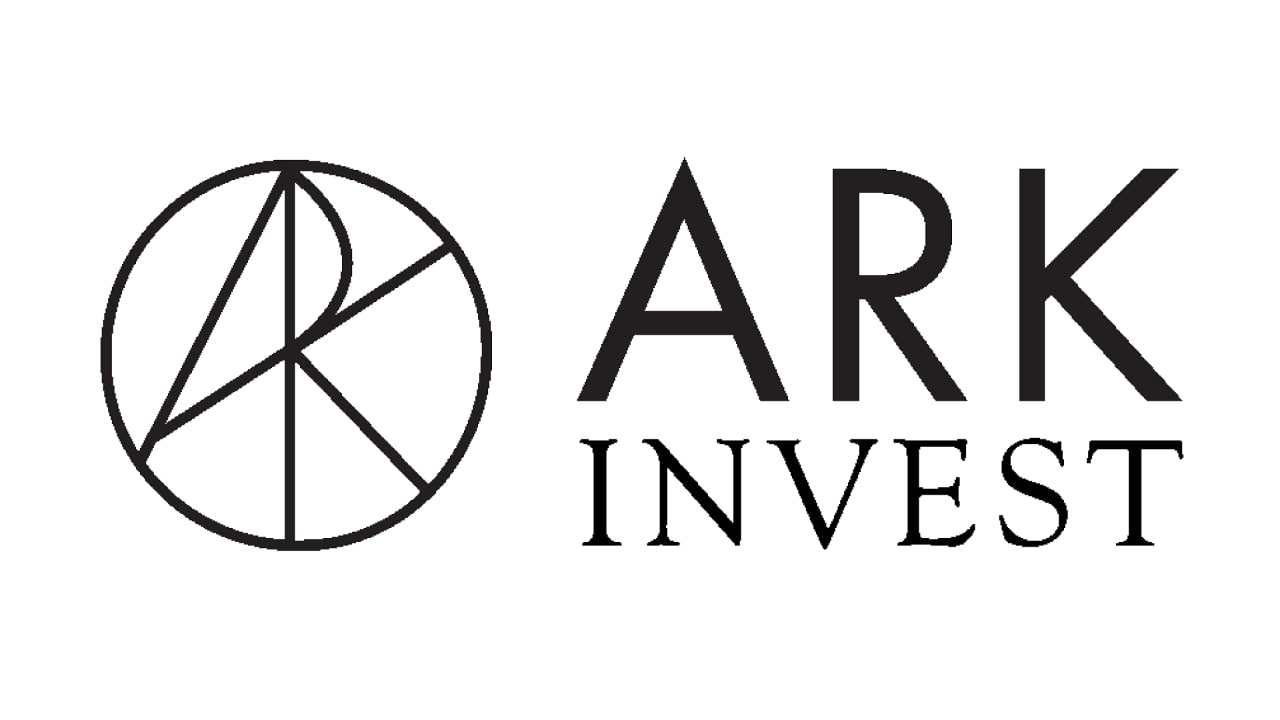
ARK Genomic Revolution UCITS ETF USD Accumulating (AAKG ETF) med ISIN IE000O5M6XO1, är en aktivt förvaltad ETF.
Den börshandlade fonden investerar i företag från hela världen som förväntas få intäkter från tekniska innovationer inom den genomiska hälsovårdssektorn. Aktierna som ingår filtreras enligt ESG-kriterier (miljö, social och bolagsstyrning).
ETFen TER (total cost ratio) uppgår till 0,75 % per år. ARK Genomic Revolution UCITS ETF USD Accumulating är den enda ETF som följer ARK Genomic Revolution-index. ETFen replikerar det underliggande indexets prestanda genom full replikering (köper alla indexbeståndsdelar). Utdelningarna i ETFen ackumuleras och återinvesteras.
Denna ETF lanserades den 12 april 2024 och har sin hemvist i Irland.
Fondsammanfattning
ARK Genomic Revolution UCITS ETF strävar efter att investera i globala aktierelaterade värdepapper från företag som är involverade i den genomiska revolutionen. Dessa är företag som är väsentligt fokuserade på eller drar nytta av att förlänga och förbättra kvaliteten på människors och andras liv genom att införliva teknisk och vetenskaplig utveckling, förbättringar och framsteg inom genomik i sin verksamhet, till exempel genom att erbjuda nya produkter eller tjänster som är beroende av genomisk sekvensering analys, syntes eller instrumentering.
Dessa företag kan inkludera sådana inom flera sektorer, såsom hälso- och sjukvård, informationsteknik, material, energi och konsumentfrågor. Dessa företag kan också utveckla, producera, tillverka eller i hög grad förlita sig på eller möjliggöra bioniska enheter, bioinspirerad datoranvändning, bioinformatik, molekylär medicin och jordbruksbioteknik.
De sjunkande kostnaderna för genomisk sekvensering och framväxten av multiomisk teknik låser upp oöverträffade möjligheter inom hälso- och sjukvården. Vår resa in i själva livets molekylära struktur förändrar vårt förhållningssätt till sjukdomar som länge har undvikit botemedel, särskilt sällsynta genetiska sjukdomar och cancer.
År 2023 uppnådde det medicinska samfundet en milstolpe med de första godkännandena för genredigeringsbehandlingar för beta-talassemi och sicklecellssjukdom i både USA och Europa, vilket signalerade en ny gryning för patienter som belastas av dessa tillstånd. Under tiden, i Storbritannien 2022, fann en ung leukemipatient hopp genom en banbrytande T-cellsterapi, vilket markerade ytterligare ett steg framåt i vår kamp mot cancer.
Denna genomiska revolution, underbyggd av innovationer inom AI och automatisering, handlar inte bara om att utvidga gränserna för traditionell medicin; det handlar om att omforma vår förståelse av livet, hälsan och potentialen för helande på molekylär nivå. När vi står på gränsen till denna nya gräns är konsekvenserna för patientvård, biologiska vetenskaper och den bredare ekonomin djupgående och förutspår en framtid där behandlingen av en gång svårlösta sjukdomar blir verklighet för alla.
Handla AAKG ETF
ARK Genomic Revolution UCITS ETF USD Accumulating (AAKG ETF) är en europeisk börshandlad fond. Denna fond handlas på Deutsche Boerse Xetra.
Det betyder att det går att handla andelar i denna ETF genom de flesta svenska banker och Internetmäklare, till exempel DEGIRO, Nordnet, Aktieinvest och Avanza.
Börsnoteringar
| Börs | Valuta | Kortnamn |
| XETRA | EUR | AAKG |
Största innehav
| Namn | ISIN | Vikt % | Valuta |
| CRISPR THERAPEUTICS AG COM CHF0.03 | CH0334081137 | 7,29 | USD |
| TWIST BIOSCIENCE CORP COM | US90184D1000 | 5,88 | USD |
| EXACT SCIENCES CORP COM | US30063P1057 | 5,49 | USD |
| RECURSION PHARMACEUTICALS INC | US75629V1044 | 5,07 | USD |
| SCHRODINGER INC COM | US80810D1037 | 4,59 | USD |
| IONIS PHARMACEUTICALS INC COM | US4622221004 | 4,14 | USD |
| BEAM THERAPEUTICS INC COM | US07373V1052 | 3,93 | USD |
| INTELLIA THERAPEUTICS INC COM | US45826J1051 | 3,93 | USD |
| 10X GENOMICS INC CL A | US88025U1097 | 3,83 | USD |
| GINKGO BIOWORKS HOLDINGS INC COM USD0.0001 | US37611X1000 | 3,59 | USD |
Innehav kan komma att förändras
Nyheter
Successfully navigate through Bitcoin & Cryptoassets Markets
Publicerad
2 timmar sedanden
23 april, 2024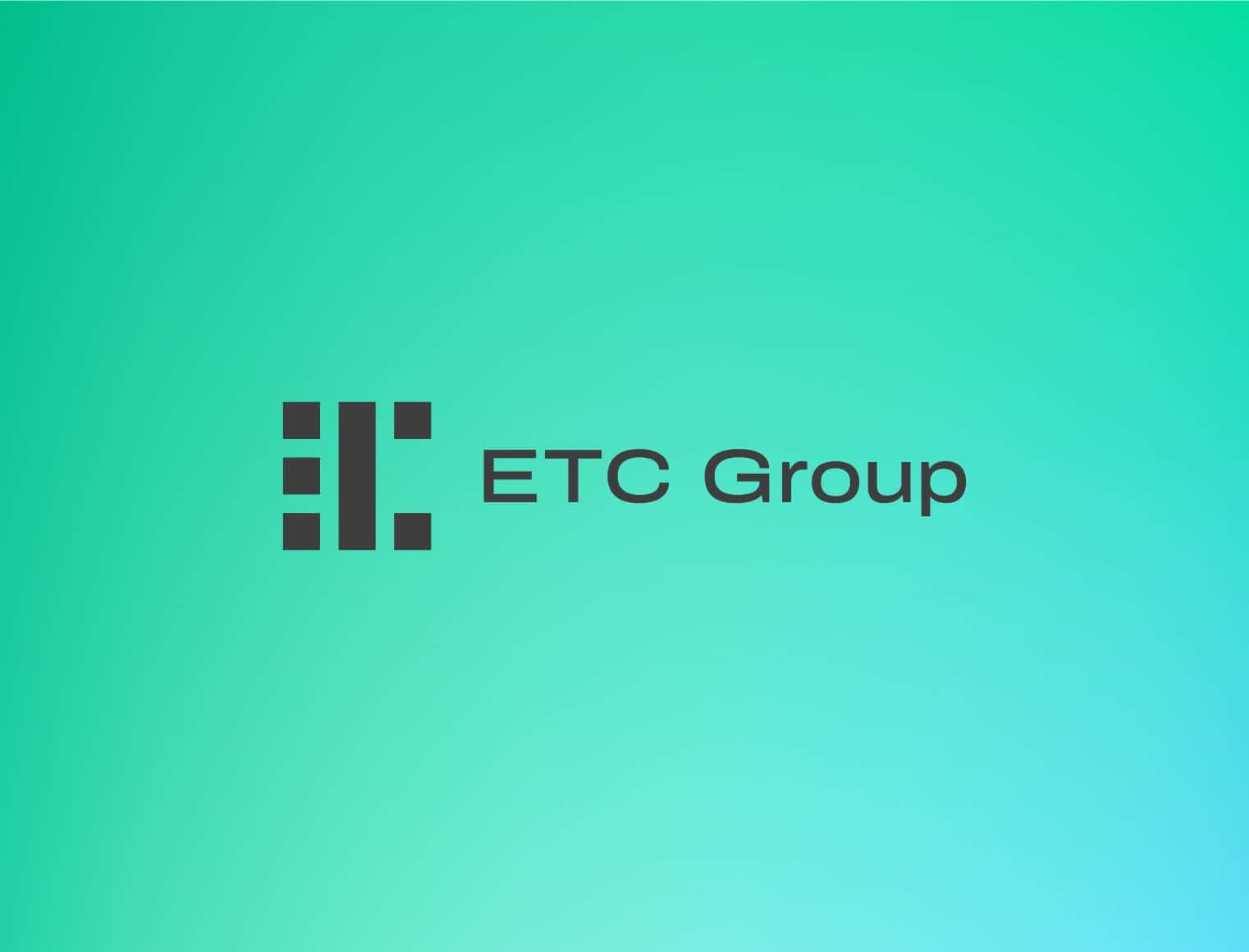
• Cryptoassets rebound from losses sparked by geopolitical tensions amid Bitcoin Halving
• Our in-house “Cryptoasset Sentiment Indicator” has also rebounded from year-to-date lows
• Bitcoin Halving: In the past, most of the positive performance accrued after the Halving event
Chart of the Week

Performance
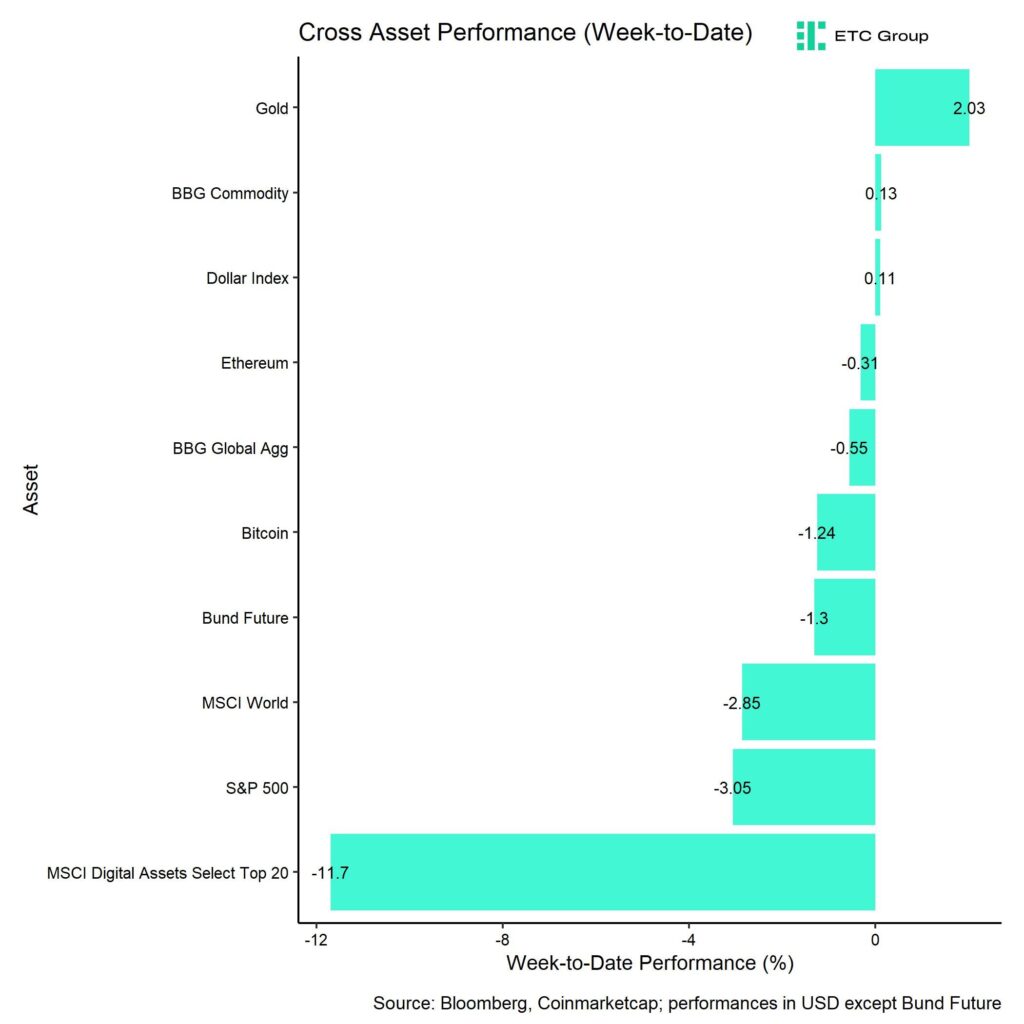
Last week, cryptoassets came under pressure on account of rising geopolitical risks in the Middle East that led to a general decline in risky assets across the board.
However, most major cryptoassets have already retraced most of these losses amid the highly anticipated Bitcoin Halving that has halved the block subsidy from 6.25 BTC per block to 3.125 BTC. The fourth Bitcoin Halving has occurred on the 20th April at 02:09:27 UTC.
We think that the positive performance effect of the Halving is not priced in and expect this effect to unfold after around 100 days after this event, i.e. around July 2024 onwards. The reason is that the supply deficit induced by the Bitcoin Halving only tends to accumulate over time and is rather insignificant in the very short term.
In general, it is important to note that most of the Halving related performance tends to accrue after Halving event dates which implies that Halving events have not been “front-run” by investors in the past. Besides, the performance differences post- and pre-Halving were so significant that the Halving effect is unlikely to be pure coincidence. Read more in our deep dive into the Bitcoin Halving here.
Along with the latest Halving, we saw a significant spike in transaction fees in the Bitcoin core network which has sparked renewed discussions around the viability of Bitcoin as a means-of-exchange. In fact, we saw a record-high in daily revenue for Bitcoin miners just yesterday of around 107 mn USD of which around 80 mn USD came from transaction fees alone.
The introduction of Runes, a new protocol that enables users to ”etch” and mint tokens on the Bitcoin blockchain, may be the cause of the fee increase. Speculators flocked to create tokens and trade meme coins as soon as Runes launched, which accelerated transaction volume and raised transaction fees.
At the time of writing, there were 3,700 Runes inscriptions total on the Bitcoin blockchain, according to data source Ord.io.
We think that these increases in transaction fees will only accelerate the usage of more cost-effective Bitcoin Layer 2 solutions like the Lightning Network and or no material risk to Bitcoin. To the contrary, the increase in transactions fees as a percentage of the overall block reward should continue to incentivize Bitcoin miners to secure the network amid decreasing block subsidies going forward.
Meanwhile, Ethereum managed to outperform Bitcoin amid the stalling bull market rallye along with a general rotation into altcoins.
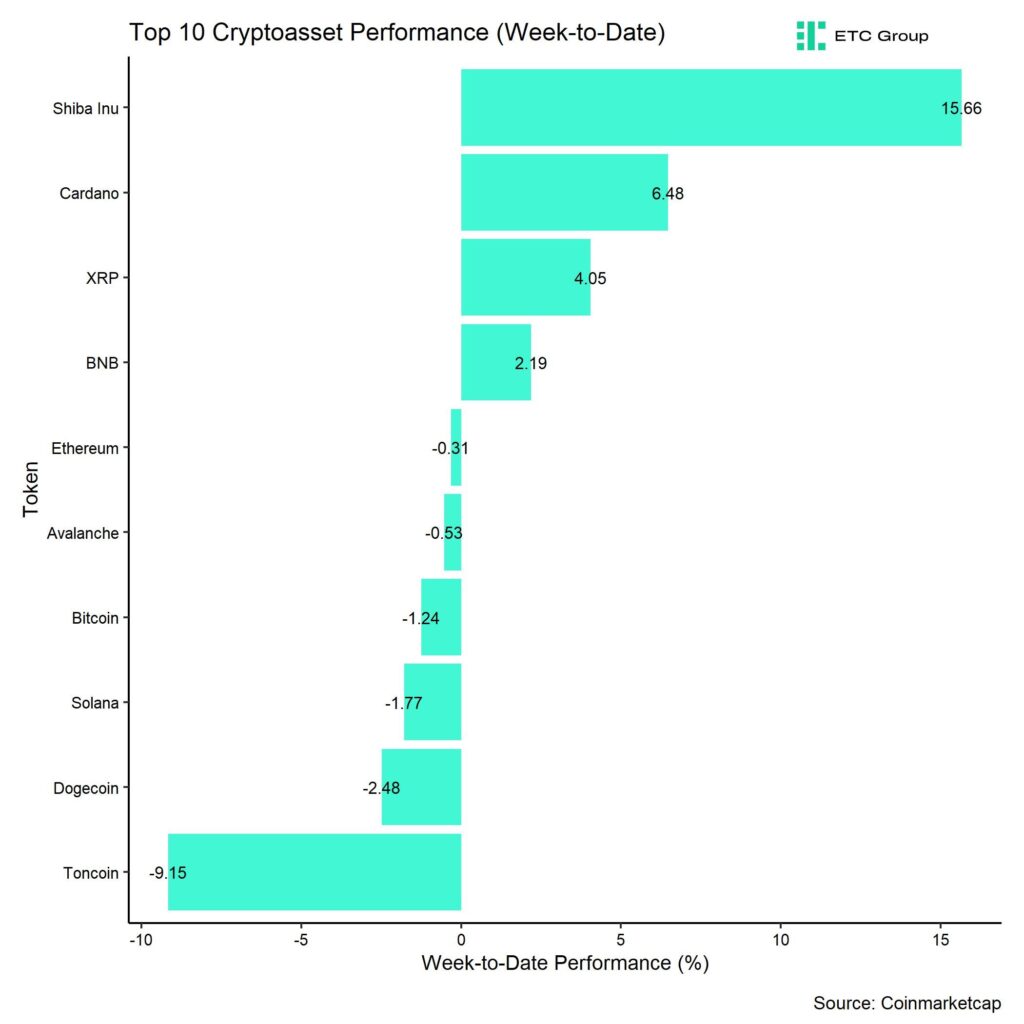
In general, among the top 10 crypto assets, Shiba Inu, Cardano, and XRP were the relative outperformers.
Overall altcoin outperformance vis-à-vis Bitcoin also picked up compared to the week prior, with around 65% of our tracked altcoins managing to outperform Bitcoin on a weekly basis.
Sentiment
Our in-house “Cryptoasset Sentiment Index” has rebounded from year-to-date lows that were induced by the rise in geopolitical tensions. The index is currently still signalling bearish sentiment.
At the moment, only 2 out of 15 indicators are above their short-term trend.
Based on the significant reduction in sentiment, we think that a short-term stabilization is very likely.
Last week, there were significant reversals to the downside in the global crypto hedge fund beta and BTC long futures liquidation dominance.
The Crypto Fear & Greed Index remains in ”Greed” territory as of this morning.
Besides, our own measure of Cross Asset Risk Appetite (CARA) has also decreased throughout the week which signals increased bearish sentiment in traditional financial markets.
Performance dispersion among cryptoassets has increased amid the recent correction. Overall performance dispersion still remains slightly elevated.
In general, high performance dispersion among cryptoassets implies that correlations among cryptoassets are low, which means that cryptoassets are trading more on coin-specific factors and that cryptoassets are increasingly decoupling from the performance of Bitcoin.
This is also consistent with the fact that altcoin outperformance vis-à-vis Bitcoin has recently picked up compared to the week prior, with around 65% of our tracked altcoins that have outperformed Bitcoin on a weekly basis. At the same time, there was a slight outperformance of Ethereum vis-à-vis Bitcoin last week.
In general, increasing altcoin outperformance tends to be a sign of increasing risk appetite within cryptoasset markets.
Fund Flows
Last week, we saw a pick-up in overall crypto ETP redemptions and net outflows amid a broad risk-off environment of around -239.7 mn USD (week ending Friday) based on Bloomberg data.
Global Bitcoin ETPs dominated with net outflows of -203.4 mn USD of which -204.6 mn (net) were related to US spot Bitcoin ETFs alone. The ETC Group Physical Bitcoin ETP (BTCE) also saw net outflows equivalent to -34.4 mn USD last week.
The Grayscale Bitcoin Trust (GBTC) continued to experience high net outflows of approximately -458.4 mn USD last week. However, other US spot Bitcoin ETFs even managed to attract +254 mn USD (ex GBTC).
Global Ethereum ETPs also saw significant net outflows last week of around -67.7 mn USD. Meanwhile, the ETC Group Physical Ethereum ETP (ZETH) had neither creations nor redemptions (+/- 0 mn USD). The same is true for the ETC Group Ethereum Staking ETP (ET32) last week.
Besides, Altcoin ETPs ex Ethereum again managed to attract net inflows of around +19.3 mn USD amid the rotation into altcoins last week.
Besides, Thematic & basket crypto ETPs also experienced net inflows of +11.9 mn USD, based on our calculations. The ETC Group MSCI Digital Assets Select 20 ETP (DA20) also experienced net inflows of around +0.8 mn USD last week.
Besides, the beta of global crypto hedge funds to Bitcoin over the last 20 trading decreased significantly to around 0.64 which implies that global crypto hedge funds have significantly reduced their market exposure and are significantly underweight relative to the market.
On-Chain Data
Despite the recent sell-off towards 60k USD in Bitcoin, coins continue to be taken off exchanges on a net basis as BTC exchange balances have recently reached a new multiyear low. Likewise, Ethereum has seen a continued drawdown in exchange balances which should provide a tailwind for the smart contract platform.
That being said, the latest sell-off saw an increase in net BTC transfers to exchanges by larger wallet sizes (>10 mn USD) which is usually a bearish signal.
This is also corroborated by positive net BTC exchange inflows from whales (entities that control at least 1,000 BTC) over the past week.
Overall net buying volumes for Bitcoin have been negative over the past week as evidenced by negative cumulative volume delta (CVD) on exchanges. The cumulative volume delta (CVD), which measures the net difference between buying and selling trade volumes, was negative with around -261 mn USD in net selling volumes over the past week.
Continuing negative US spot Bitcoin ETF fund flows were certainly a major driver of this selling volume.
In our latest report at the end of March, we wrote:
“Ongoing consolidation appears to be relatively likely in the short term despite the upcoming Bitcoin Halving in April. The reason is that the positive effects from the Halving only become visible around 100 days after the Halving according to our latest analyses.
If the market was trading lower, we should find support in Bitcoin near 55.4k USD as the short-term holder’s cost basis is around that price level. Short-term holders tended to capitulate whenever the price dipped below their cost basis which should provide a solid basis for a continuation of the bull market.”
We still expect this to be our base case although the significant decrease in Cryptoasset Sentiment Index has made a short-term stabilization very likely.
The spike in inscriptions induced network activity and fees in the Bitcoin network could also be a headwind in the short-term as active addresses have plunged to year-to-date lows recently.
This implies that high transaction fees are somewhat leading to lower usage of the Bitcoin network as users might be waiting for lower fess. Transaction fess are already becoming increasingly prohibitive for some users.
Futures, Options & Perpetuals
Last week, there was a general decline in both Bitcoin futures and perpetual open interest due to increased liquidations and a general de-risking in positioning.
Bitcoin futures open interest on CME also continued to decrease. Since the peak in open interest on the 20th of March, open interest in Bitcoin CME futures has already declined by -29k BTC.
Consistent with this development the Bitcoin futures basis also continued to decline. At the time of writing, the 3-months annualized Bitcoin futures basis rate is at around 10.0% p.a. which marks a significant decline from the highs observed at the end of March (~30.4% p.a.).
The Bitcoin perpetual funding rate also declined significantly and also went negative on Thursday last week.
In contrast, Bitcoin options’ open interest even increased slightly last week. The Put-call open interest went sideways last week. There was also no significant spike in relative trading volumes between puts and calls that you would normally expect during a sell-off like last week.
That being said, the 25-delta BTC 1-month option skew increased significantly as BTC options traders paid significantly higher volatility premia for puts than for delta-equivalent calls. Skews have normalized a bit more recently though.
Meanwhile, BTC option implied volatilities remained relatively elevated. Implied volatilities of 1-month ATM Bitcoin options are currently at around 69.7% p.a.
Bottom Line
• Cryptoassets rebound from losses sparked by geopolitical tensions amid Bitcoin Halving
• Our in-house “Cryptoasset Sentiment Indicator” has also rebounded from year-to-date lows
• Bitcoin Halving: In the past, most of the positive performance accrued after the Halving event
To read our Crypto Market Compass in full, please click the button below:

Disclaimer
Important Information
The information provided in this material is for informative purposes only and does not constitute investment advice, a recommendation or solicitation to conclude a transaction. This document (which may be in the form of a blogpost, research article, marketing brochure, press release, social media post, blog post, broadcast communication or similar instrument – we refer to this category of communications generally as a “document” for purposes of this disclaimer) is issued by ETC Issuance GmbH (the “issuer”), a limited company incorporated under the laws of Germany, having its corporate domicile in Germany. This document has been prepared in accordance with applicable laws and regulations (including those relating to financial promotions). If you are considering investing in any securities issued by ETC Group, including any securities described in this document, you should check with your broker or bank that securities issued by ETC Group are available in your jurisdiction and suitable for your investment profile.
Exchange-traded commodities/cryptocurrencies, or ETPs, are a highly volatile asset and performance is unpredictable. Past performance is not a reliable indicator of future performance. The market price of ETPs will vary and they do not offer a fixed income. The value of any investment in ETPs may be affected by exchange rate and underlying price movements. This document may contain forward-looking statements including statements regarding ETC Group’s belief or current expectations with regards to the performance of certain asset classes. Forward-looking statements are subject to certain risks, uncertainties and assumptions, and there can be no assurance that such statements will be accurate and actual results could differ materially. Therefore, you must not place undue reliance on forward-looking statements. This document does not constitute investment advice nor an offer for sale nor a solicitation of an offer to buy any product or make any investment. An investment in an ETC that is linked to cryptocurrency, such as those offered by ETC Group, is dependent on the performance of the underlying cryptocurrency, less costs, but it is not expected to match that performance precisely. ETPs involve numerous risks including, among others, general market risks relating to underlying adverse price movements and currency, liquidity, operational, legal, and regulatory risks.
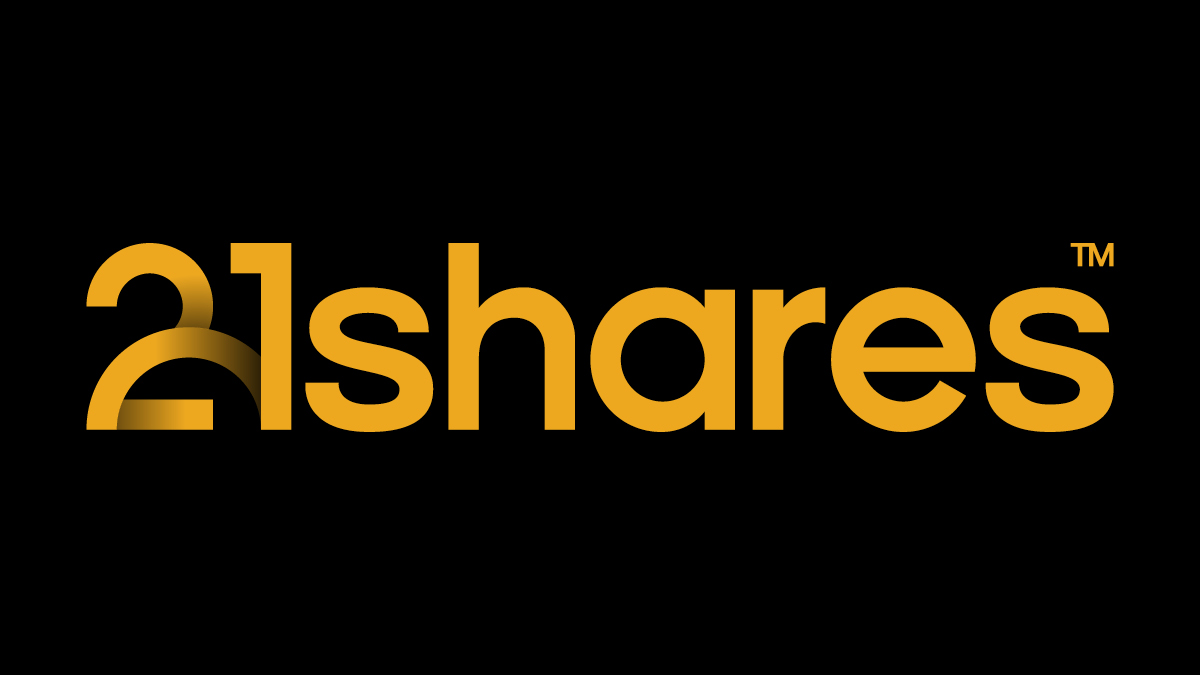
Discover the latest insights on the Bitcoin halving event.
Get our report to understand how the upcoming halving in April will impact the market, mining community, and the Bitcoin ecosystem.
Download Full Report

What is the Bitcoin Halving?
The Bitcoin halving is a programmed event that reduces the reward for mining new coins by 50% approximately every four years, ultimately limiting the total supply of Bitcoin, akin to the scarcity of gold. This mechanism, embedded in Bitcoin’s protocol, aims to maintain its value proposition as a decentralized, fixed and immutable monetary system, although its performance is influenced by various factors that go beyond the halving.
How are miners impacted by the halving?
The Bitcoin halving impacts miners through reduced block rewards and shifts in profitability, influenced by Bitcoin’s price fluctuations. Miners may seek refinancing options to sustain operations, while decreased mining difficulty during downturns encourages cost-effectiveness and strengthens the network. As a result of this cycle’s unique demand, miners are selling less BTC on exchanges, indicating a more bullish stance amidst price surges and increased market accessibility driven by ETF inflows.
How can I get access via ETPs?
Easily access Bitcoin through Exchange-Traded Products (ETPs) listed on regulated exchanges. With these ETPs, you can trade Bitcoin via your regular brokerage accounts without the need for a digital wallet. Rest assured as you invest confidently, supported by transparent documentation and similar tax treatments as traditional ETPs or securities. Start trading Bitcoin ETPs today for a seamless investment experience that combines the convenience of traditional trading with the potential of cryptocurrency assets.
Bitcoin Key Metrics
Explore our meticulously crafted Dune Dashboards. Click below to uncover essential insights and track the countdown to the next halving event.
EXPLORE BITCOIN DASHBOARDS
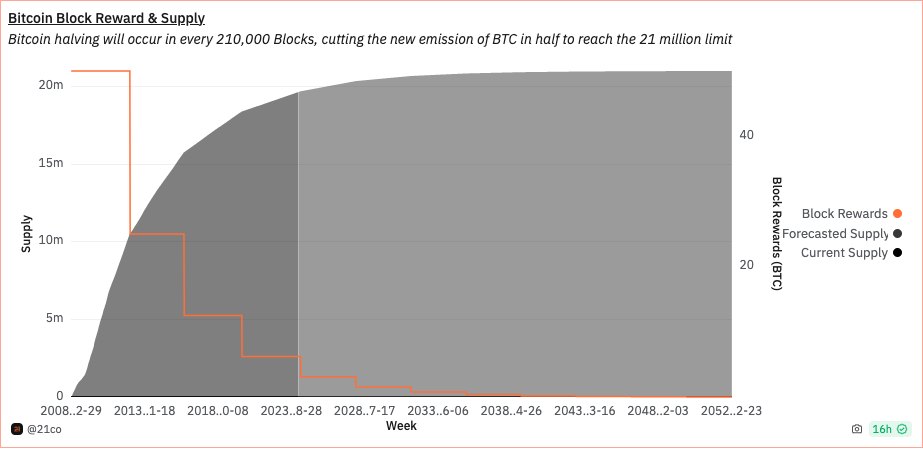
Featured Products
Explore our Bitcoin ETPs for streamlined cryptoasset investment.
2BTD
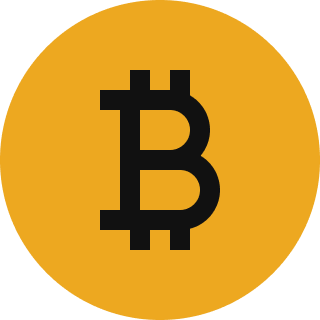
21BC
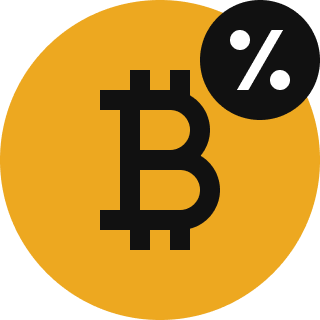
Reach out to learn more about Bitcoin & Halving and download the report
Research Newsletter
Each week the 21Shares Research team will publish our data-driven insights into the crypto asset world through this newsletter. Please direct any comments, questions, and words of feedback to research@21shares.com
Disclaimer
The information provided does not constitute a prospectus or other offering material and does not contain or constitute an offer to sell or a solicitation of any offer to buy securities in any jurisdiction. Some of the information published herein may contain forward-looking statements. Readers are cautioned that any such forward-looking statements are not guarantees of future performance and involve risks and uncertainties and that actual results may differ materially from those in the forward-looking statements as a result of various factors. The information contained herein may not be considered as economic, legal, tax or other advice and users are cautioned to base investment decisions or other decisions solely on the content hereof.

AAKG ETF ger exponering mot tekniska innovationer inom den genomiska hälsovårdssektorn

Successfully navigate through Bitcoin & Cryptoassets Markets

The Bitcoin Halving and Beyond

GinsGlobal lyfter fram unik investeringsmetod i utvecklande tekniskt landskap

JPHG ETF ger exponering mot 400 japanska aktier, hedgat i brittiska pund

ETFmarknaden i Europa firar sitt 24-årsjubileum med tillgångar på två biljoner USD

De mest populära börshandlade fonderna mars 2024

3 ETF:er du nog inte visste finns

FUIG ETF investerar i hållbara företagsobligationer som följer Parisavtalet

Ny fond ger tillgång till företag från tillväxtmarknader exklusive Kina
Populära
-

 Nyheter7 dagar sedan
Nyheter7 dagar sedanETFmarknaden i Europa firar sitt 24-årsjubileum med tillgångar på två biljoner USD
-

 Nyheter3 veckor sedan
Nyheter3 veckor sedanDe mest populära börshandlade fonderna mars 2024
-

 Nyheter4 veckor sedan
Nyheter4 veckor sedan3 ETF:er du nog inte visste finns
-

 Nyheter3 veckor sedan
Nyheter3 veckor sedanFUIG ETF investerar i hållbara företagsobligationer som följer Parisavtalet
-

 Nyheter4 veckor sedan
Nyheter4 veckor sedanNy fond ger tillgång till företag från tillväxtmarknader exklusive Kina
-

 Nyheter1 vecka sedan
Nyheter1 vecka sedanTillgång till obligationsmarknaden för företagsobligationer från utvecklade marknader
-
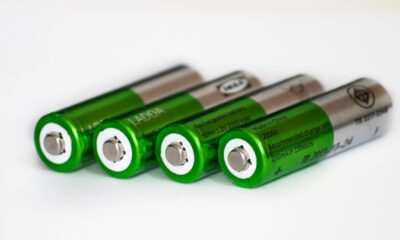
 Nyheter4 veckor sedan
Nyheter4 veckor sedanFonder för att investera i batteriboomen…
-

 Nyheter2 veckor sedan
Nyheter2 veckor sedanFörsvarsfond når förvaltad volym på 500 MUSD


